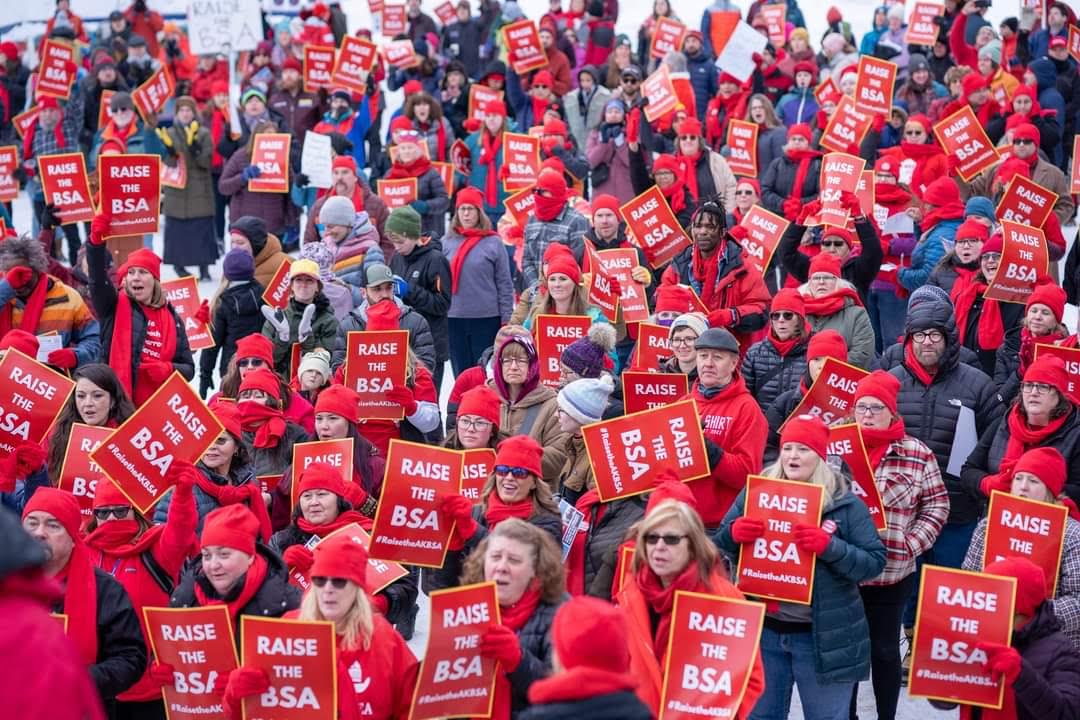More Money, Worse Outcomes: The Problem With Alaskan Education
If you've been to the capitol lately, it's not unlikely that you've heard the loud chants echoing through the building's chambers, those loud cries of "raise the BSA!"

Perhaps you've heard about the walkout of students across Alaska yesterday, protesting Mike Dunleavy's veto of Senate Bill 140. All these advocates suggest spending more and more on Alaska's education, but the facts show that despite spending more on education, Alaska receives worse outcomes. As you will see in this article, Alaska spends more on education than most other states in the Union, yet our education sits consistently near last on national rankings. We will examine if the solution is truly to throw more money at the BSA and school districts, or if the solution might be something more tactful.
Alaska is a state that is known for many things, but high-quality education is not one of them. According to the 2022 National Assessment of Educational Progress, Alaska's fourth graders rank 49th nationwide in reading, and are fifteen months behind the national average. Only one in four Alaskan students are reading at grade level, and the state ranks 49th overall in educational quality according to U.S. News and World Report. These statistics are concerning–everybody agrees that Alaska has an education problem and Alaska's legislators have looked increasingly into education reform and investigating why our schools have such bad performance.
But they actually haven't been–many in our state suggest we simply spend more money.
Enter Senate Bill 140. Senate Bill 140 (SB140) proposed allocating a 175 million dollar boost in aid to school districts across the state of Alaska, making it the largest nominal increase to school funding in Alaska's history. This amount would also increase the Base Student Allocation, the amount of money that is allocated to school districts per student. The bill passed initially with widespread bipartisan support, but it soon ended up being vetoed by Governor Dunleavy as it didn't include many of the provisions that he wished to be included in such a bill. Legislators attempted to override this veto, but the motion failed by just one vote, and the veto remained in place, shutting down Senate Bill 140.
Calls to raise the base student allocation are loud despite Alaska already spending significant sums on education. This is shown by evidence. In the 2018-19 school year, Alaska was the 9th highest-spending state nationwide per pupil, even after adjusting the amount to Alaska's cost of living. In February of this year, Deena Bishop, Commissioner of the Department of Education and Early Development, estimated that the per-student cost in Alaska stands at roughly $23,692. This amount is worth noting because it shows just how much our state spends compared to other states, only to have worse outcomes than those other states.
Not only that, but if you examine Alaska's educational performance since 2003, you will find stagnation in test scores despite consistent increases in educational spending. From 2003 to 2020, Alaska's educational expenditure increased by one third, even adjusting for inflation. Of this amount, there was a whopping 50% increase in state spending alone. Despite this constant increase in spending, educational outcomes have failed to improve at all. Alaska continues to rank in the bottom 10 states in education since 2003. Throwing money at the problem has never worked before, so clearly the issue with our education goes much deeper than the dollar amount.
But I'm not going to condemn the proposed increase in spending without offering a solution myself. I am of the belief that the problem with Alaska's education lies not with the amount of money allocated to education, but to where that money is going. Studies indicate that much of the funding increases do not go towards teachers. They don't even go towards students. They often go towards administrators.
I love administrators as much as the next guy, but teachers are much more important to educational outcomes. That being said, it is therefore concerning to learn that for every four teachers in Alaska, there are five non-teachers. The state has more non-teachers than teachers! From 2002 to 2020, teacher salaries saw a mere 1% increase. Administrative salaries, meanwhile, received an 18% increase, with other non-teacher salaries seeing a 42% increase. Furthermore, a large portion of the covid money given to Alaskan schools ended up going towards these administrative and non-teacher staff salaries. No wonder our state has such bad teacher retention. With this in mind, it makes sense why Dunleavy tried to press the legislature so hard to include his teacher bonus plan in the bill, and it should make increasing sense as to why he vetoed it.
In order to fix Alaska's education, we need to step back and think about what exactly it is that our money is being spent on. Is it truly being spent on teachers, the ones who educate our students, or is too much of it being spent on administration, who have reaped most of the reward from our state's increased expenditures. If it's the latter, then is throwing more money at the problem really the best solution?